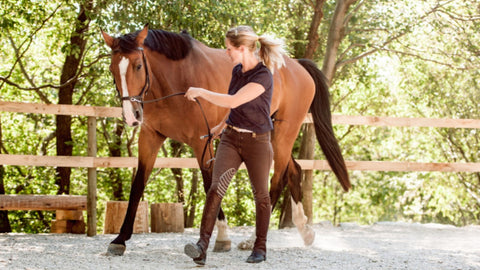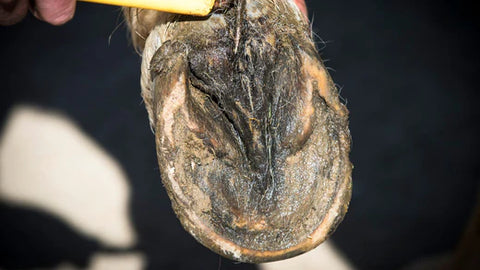
Florian ist aufgewachsen auf einem Bauernhof. Umgeben von Pferden, entdeckte er früh seine Faszination für diese majestätischen Tiere. Inspiriert von seiner reitbegeisterten Mutter, entwickelte er das Nahrungsergänzungmittel - Pferdegold. Seine tiefe Verbundenheit zur Natur und die leidenschaftliche Hingabe zu Pferden trieben ihn an, sein Unternehmen zu gründen.
"Kissing spines" is a term that causes concern in the horse world. This term may sound romantic at first, but the reality is different.
The "kissing spinous processes" are by no means a sign of affection. In fact, they conceal a serious and incurable spinal condition.
Horses suffering from this condition often exhibit significant symptoms that can impair riding and jumping. In this guide, you'll learn more about the causes, symptoms, and possible exercises for relief.

Kissing Spines in Horses: What Is It?
Kissing spines is a condition in which the spinous processes of the vertebrae move dangerously close to each other . This proximity can become so intense that they touch and rub against each other .
This leads to pain and restricted movement in the horse.
It is important to recognize the signs early in order to provide the horse with the best possible care and treatment.
If left untreated, this condition can lead to long-term complications and significantly impact your horse's overall well-being.
However, if you are well informed about kissing spines, you can act quickly if you suspect it and provide your pet with the appropriate treatment .
Possible causes of kissing spines
The main cause of kissing spines is long-term tension and insufficient back muscles. When the muscles are tense, they contract the vertebral bodies, causing the cartilage between the vertebrae to wear away.
Other factors may include genetic predisposition , trauma , or improper training .
It is crucial to understand the causes of kissing spines in order to best protect your horse and take preventative measures.
In order to protect your horse from this and to increase endurance and performance, the muscles must be supplied with important nutrients.

Perfect for your horse: Pferdegold® supplementary feed!
These specially developed supplements support your horse's diet and provide it with natural nutrients. Made in Germany, grain-free and drug-free, they come with a 30-day money-back guarantee.
Try it now!How does a horse with kissing spines behave?
A horse with kissing spines often shows clear signs of discomfort. To identify kissing spines in a horse, you should therefore look for changes in behavior and physical signs . Many horses move less due to the pain, become lame, or show saddle resistance . Another sign can be an irregular canter that is not in the correct three-beat cadence.
It is important to pay attention to such symptoms in order to intervene in a timely manner.
Symptoms of Kissing Spines:
- Lameness or stiffness when moving
- Saddle pressure
- Irregular canter
- Avoiding certain movements or exercises
- Signs of pain when brushing or touching the back
- Resistance to the rider mounting
- Changed behavior, e.g. aggression or withdrawal
This list is not exhaustive, and it is always advisable to consult a veterinarian if you suspect anything.

How is kissing spines diagnosed?
Diagnosing kissing spines requires a thorough examination by an experienced veterinarian. One of the most reliable methods for diagnosing this condition is using x-rays.
In the case of kissing spines, the veterinarian can see on the x-rays exactly how close the spinous processes of the vertebrae are to each other and whether they are touching or rubbing.
This provides a clear insight into the severity of the disease and helps in planning further treatment for the horse.
It is important to have a thorough diagnosis made if signs of kissing spines appear in your horse so that appropriate measures can be taken in a timely manner.
Can you ride a horse with kissing spines?
Yes, it is possible to ride a horse with kissing spines, but it depends very much on the severity of the condition and the horse's individual pain level.
Some horses with milder cases can be ridden without problems as long as they are treated and cared for properly.
It's important to always keep an eye on the horse's well-being and pay attention to any signs of discomfort or pain. In more severe cases of kissing spines, riding can place too much strain on the horse and should be avoided.
Inadequate nutrient supply is a cause of poor endurance and low performance. To protect your horse from this and to increase endurance and performance, the muscles must be supplied with important nutrients.
Which horses are prone to kissing spines?
Kissing spines can affect horses of all breeds and ages . However, there are some factors that can increase the risk.
Horses with a long, flat back or with a genetic predisposition may be more susceptible to this condition.
This is because with such back shapes the spinous processes can be closer together, which increases the risk of friction.
Likewise, horses subjected to intensive training or specific equestrian sports may be at higher risk.
Despite these risk factors, kissing spines is not limited to a specific group of horses, so regular health checks and care are recommended for all horses.
Treating Kissing Spines in Horses: Tips
Treating kissing spines requires a combination of targeted exercises, proper nutrition, and regular care . With the right strategies, you can help your pet relieve symptoms and improve their well-being.
1. Exercise and relaxation
Exercise is key. We all know this from our own experience. If you just sit around lazily on the couch, you won't build muscle. It's no different for four-legged friends. Horses with kissing spines are especially dependent on well-developed muscles.
But before you begin, your four-legged friend should first relax . After all , prolonged, severe tension is the main cause of kissing spines. How can you get rid of this?
With a gentle round of rolling on the ground . While rolling, the horse stretches and extends itself with pleasure in all directions – a real treat that helps you relax.
2. Lunging and other exercises
Another classic is the so-called carrot stretch . It works like this: You hold out a carrot to your horse. It will immediately follow with its head to sniff out the delicious treat. For example, if your horse stretches its head as far forward and down as possible, the neck and back muscles are automatically stretched .
Then it's time to lunge , but definitely not with side reins and reins! This is counterproductive for a horse with kissing spines. Working with a cavesson , on the other hand, is ideal, as this teaches the horse to carry itself and move from back to front over the back. Working in hand is also helpful.
One of the most important exercises of all: letting the reins chew from the hand . This teaches the horse how to properly load muscles, tendons, ligaments , and joints. Tension is thus effectively relieved .
You should always include this exercise in your training.

3. Targeted training
Transitions and changes in pace have also proven effective in loosening up the back. These should also be included regularly in your training plan.
Through targeted training, muscles can be strengthened and the mobility of the horse's back improved. It's important to increase training slowly and always pay attention to the horse's reactions. A well-thought-out training plan can play a decisive role in alleviating the symptoms of kissing spines.
4. Muscle food and nutritional supplements
When it comes to horse feeding for Kissing Spines, there are some key components in the diet that should be considered.
Every fitness freak knows : muscles love protein . And amino acids, in turn, are the building blocks of proteins. So muscles—and the battered horse's back—most likely crave high-quality amino acids.
Therefore: feed amino acids!
And there is another building block that could almost be called the “relaxation mineral” : magnesium .
The body needs magnesium for protein synthesis and muscle function. Sore muscles or calf cramps after the gym? Quickly dissolve a magnesium tablet in water. This can be helpful for tense muscles.
Even horses sometimes crave magnesium. (Of course, not in the form of effervescent tablets for humans!)
Other important nutrients that can support a horse with kissing spines: manganese and vitamin E (tocopherol) .
A manganese deficiency may lead to tension , which can compress the spinous processes via the muscles.
In some cases, a vitamin E deficiency can even cause damage to the muscles, nervous system, and liver. Therefore, manganese and vitamin E are a good idea for the feed trough.
Conclusion
Your horse's health and well-being always come first. Kissing spines are undoubtedly challenging, but with the right knowledge and tools, many horses can be helped to live a pain-free and comfortable life despite a kissing spine diagnosis.

Pferdegold® supplementary feed!
Pferdegold is a small family business from Bavaria with a big dream: to produce the best horse feed. We see ourselves as a family of equestrians who want to provide your horse with the ideal nutrition. 100% natural and perfectly tailored to your horse's needs.
Try it now!FAQ
Can you feel kissing spines?
Kissing spines themselves are often not directly palpable. However, horses with this condition may react sensitively or painfully to pressure along the spine. However, an accurate diagnosis requires a veterinary examination and x-rays.
Which saddle pad is recommended for kissing spines?
A well-padded and pressure-distributing saddle pad can help minimize pressure on the spine. Choose a pad specifically designed for horses with back problems and check the fit and condition of the saddle pad regularly.
Is kissing spines hereditary in horses?
There is evidence that a genetic component may play a role, but the exact cause of kissing spines is not yet fully understood. While some studies suggest a possible heritability, more research is needed to definitively confirm this. It is important to remember that many factors, including environment, training, and grooming, can influence the occurrence of this condition.
Important:
Pferdegold is not a substitute for veterinary diagnosis or treatment. The information contained in this article is for general informational purposes only and is intended to help improve your horse's well-being.
Pferdegold products do not treat or cure diseases , but rather support your horse in compensating for nutritional deficiencies through targeted nutrient intake .
However, they are not a substitute for professional advice from a veterinarian or specialist. If your horse has any health problems, we strongly recommend consulting a veterinarian. Pferdegold assumes no liability for decisions made based on the information provided here.
🐎 Want to learn more about horse health? Check out our other articles:
















